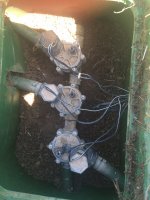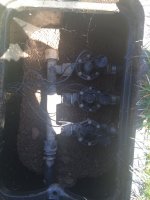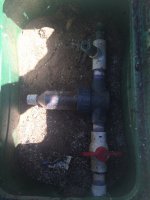05cavalier
New Member
Hello guys/gals. This is the first spring that I'm a homeowner and I'm looking to start up my irrigation system. I had a local company come blow it out and winterize it but they don't have openings to come turn it back on for another 2 weeks so I'd like to learn to do it myself. I've looked online but I haven't really found a set of instructions or even a setup similar to mine. I'm not extremely familiar with terminology so I apologize in advance for that. Also thank you in advance to anyone who offers help.
My basic setup is I have 2 in-ground access boxes in the backyard, and 1 in the front. The 2 in the backyard have 3 solenoid's each though they appear to be different between the 2 boxes - not sure why. The front yard has a single pipe with 1 red handled valve, another smaller metal handle, and then another device which I'm not sure what is or what it does. There's only one pipe in the front yard box. Pictures are below:
Backyard box 1:

Backyard box 2:

Front yard box:

Not pictured: there's a timer control box on the wall in the garage.
So the question is: what is the process for getting everything turned on correctly? I guess I was expecting a lot more piping and valves, back flow, etc. I wasn't prepared for just 1 red handle and it seems too simple to just slowly turn it until it's parallel with the pipe.
My basic setup is I have 2 in-ground access boxes in the backyard, and 1 in the front. The 2 in the backyard have 3 solenoid's each though they appear to be different between the 2 boxes - not sure why. The front yard has a single pipe with 1 red handled valve, another smaller metal handle, and then another device which I'm not sure what is or what it does. There's only one pipe in the front yard box. Pictures are below:
Backyard box 1:

Backyard box 2:

Front yard box:

Not pictured: there's a timer control box on the wall in the garage.
So the question is: what is the process for getting everything turned on correctly? I guess I was expecting a lot more piping and valves, back flow, etc. I wasn't prepared for just 1 red handle and it seems too simple to just slowly turn it until it's parallel with the pipe.
